110 Search Results for rating scale
July 25, 2012
by Carole Zangari -
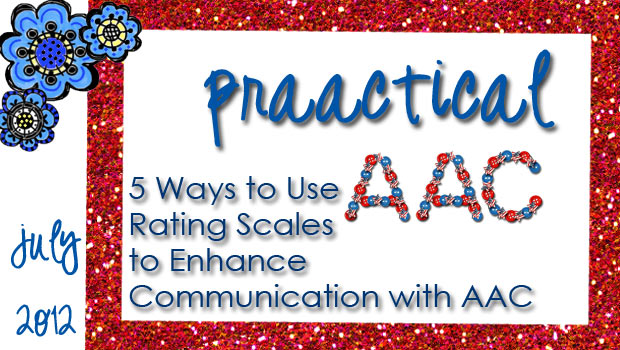
In an earlier post, we lamented the under-utilization of a quick and effective strategy: qualitative rating scales. You may not know them by that name, but we all know them. Also called Likert-type scales, we’ve seen these a multitude of times when we were asked to give an opinion. Strongly agree to Strongly Disagree. Excellent to Poor. Always to Never. – There are only a few guidelines to using these with AAC folks. One is to make sure to use appropriate visual supports. Literate AAC users may be very comfortable with text-only options, but for other learners, we need to add images so it makes sense to them. Another suggestion is to stick with an odd number of options: 5 seems to be the norm in clinical practice, but you can certainly adjust to fit the learner’s needs. For some, a 3-point scale would be best. Others may want more... [Read More...]
January 9, 2014
by Carole Zangari -
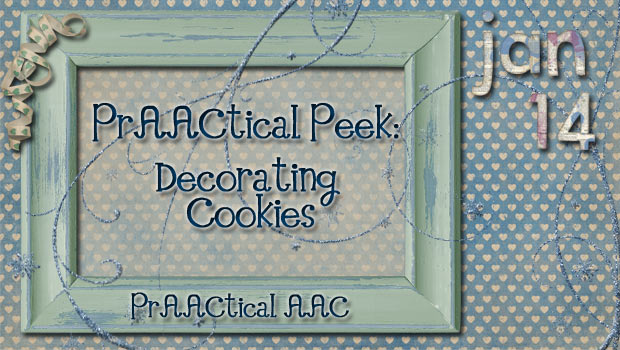
Welcome to PrAACtical Peek, an occasional series which features photos of therapy materials we use. This one is interactive, so have fun exploring the hot spots. Also, we’d love to have YOU get in on the fun. Send us a photo of some of your AAC materials for a future PrAACtical Peek post.
November 18, 2012
by Carole Zangari -
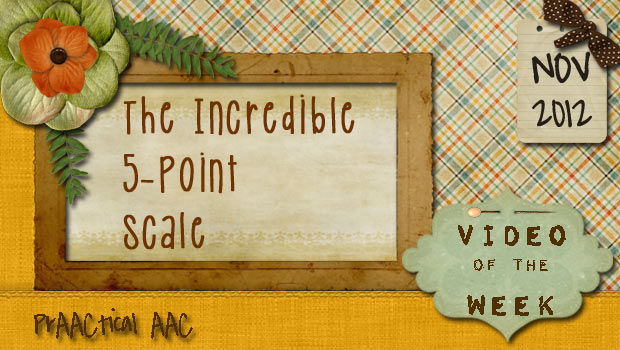
In an earlier post we listed some of our favorite strategies that aren’t as widely used as they could be in AAC intervention. Among them, was qualitative rating scales, or Likert-type scales. We use them for a variety of purposes and love their potential for expressive communication. – In this video, from From Autism and Tertiary Behavior Supports Project of the Kansas Technical Assistance Network, you’ll learn one way of using simple rating scales to help people with ASD regulate their own behavior. We like the detailed implementation information presented in The Incredible 5-point Scale. –
October 31, 2024
by Carole Zangari -
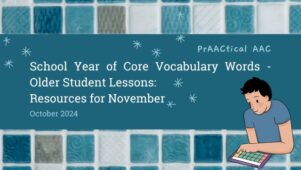
It’s prAACtically November, which means we’re ready for some fun ideas for supporting core vocabulary learning in older students. Guest authors Michaela Sullivan and Lindsay Dougherty put together some helpful resources for you to use with your AAC learners. Don’t miss the great information they share on customizing AAC devices/apps. Enjoy! SCHOOL YEAR OF CORE – Older Student Lessons Access & Copy below: Weeks 1-2 Google Slides Weeks 3-4 Google Slides INTRODUCTION- NOVEMBER 2024 We hope that the School Year of Core (SYOC-OSL) resource can provide you and your students with support in learning about core vocabulary through thematic activities and icebreakers. This crisp and magical time of year provides opportunities for learning core vocabulary. In November, we will be celebrating Thanksgiving and reflecting on Native American History. We will also be diving into themes including art, cooking, weather, clothing, household items and discuss why we turn back our clocks for... [Read More...]
September 26, 2024
by Carole Zangari -
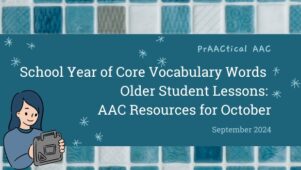
It’s prAACtically October, AAC Awareness Month! Guest authors Michaela Sullivan and Lindsay Dougherty are back with wonderful ideas for your older students who are building their skills with core vocabulary. Don’t miss the slide decks full of activities and the data collection forms specific to the October core words. In this post, they also discuss how the the importance of following the AAC user’s lead. SCHOOL YEAR OF CORE- Older Student Lessons Access & Copy below: Weeks 1-2 Google Slides Weeks 3-4 Google Slides INTRODUCTION- OCTOBER 2024 We hope that the School Year of Core (SYOC-OSL) resource can provide you and your students with additional support in learning about core vocabulary through thematic activities and icebreakers. This busy and fun time of year provides opportunities for celebration as we learn core vocabulary. In October, we celebrate holidays and celebrations across various cultures such as Halloween, Day of the Dead/Dia De... [Read More...]
August 29, 2024
by Carole Zangari -
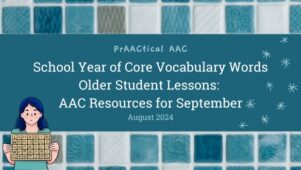
As August draws to a close, we welcome guest authors Michaela Sullivan and Lindsay Dougherty, who are back with another set of core vocabulary resources for teaching older students. Today, they share sets of curated materials and suggestions to help students gain fluency with the September core vocabulary words. They also discuss a key AAC support strategy, using pause time in AAC interactions. SCHOOL YEAR OF CORE- Older Student Lessons The Google Slide Resources Access & Copy below: Weeks 1-2 Google Slides Weeks 3-4 Google Slides INTRODUCTION- SEPTEMBER 2024 School is back in session across the country, and fall is upon us. This is a busy time of year as we prepare for the year ahead. We hope that the School Year of Core-Older Student Lessons (SYOC-OSL) resource can provide you and your students with additional support in learning about core vocabulary through thematic, engaging, and motivating activities and icebreakers.... [Read More...]
July 25, 2024
by Carole Zangari -
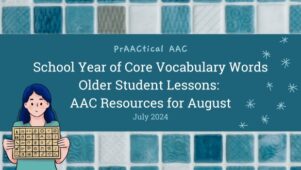
As we prepare for a new academic year, we’re delighted to reconnect with guest authors Michaela Sullivan and Lindsay Dougherty. Today, they kick off preparation for the upcoming school year with another wonderful set of Older Student Lessons in the School Year of Core Vocabulary Words series. Scroll down for some terrific resources, including two slide decks full of activities and the data collection forms specific to the Sugust core words. Their post also includes some helpful information on a key AAC support strategy, aided language input. SCHOOL YEAR OF CORE- Older Student Lessons Access & Copy below: Weeks 1-2 Google Slides Weeks 3-4 Google Slides INTRODUCTION- AUGUST 2024 Welcome back to the School Year of Core – Older Student Lessons: August! School is back in session for many and the summer is nearing the final stretch. Welcome back to the School Year of Core- Older Student Lessons (SYOC-OSL resource,... [Read More...]
May 30, 2024
by Carole Zangari -
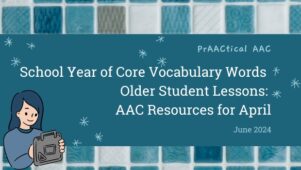
Here in the US, the school year is just about over, but there’s still enough time to welcome back guest authors Michaela Sullivan and Lindsay Dougherty for another set of Older Student Lessons in the School Year of Core Vocabulary Words series. As usual, they share some wonderful resources including two slide decks full of activities and the data collection forms specific to the June core words. They also provide a perspective on the presumption of competence and share their thoughts on its role in AAC. SCHOOL YEAR OF CORE- Older Student Lessons Access & Copy below: Weeks 1-2 Google Slides Weeks 3-4 Google Slides INTRODUCTION- JUNE 2024 Welcome back to the School Year of Core – Older Student Lessons: June! Summer is finally here, and we are celebrating with new core words and themes for the month of June. Engage in core word-centered activities centered around the end of... [Read More...]
April 25, 2024
by Carole Zangari -
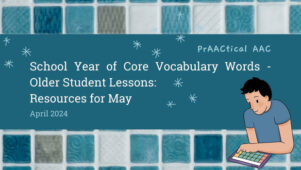
It’s prAACtically May! Guest authors Michaela Sullivan and Lindsay Dougherty are back with wonderful ideas for your older students who are building their skills with core vocabulary. Don’t miss the slide decks full of activities and the data collection forms specific to the May core words. In this post, they also discuss how the Participation Model and participation planning can support our AAC practices. SCHOOL YEAR OF CORE- Older Student Lessons Access & Copy below: Weeks 1-2 Google Slides Weeks 3-4 Google Slides INTRODUCTION- MAY 2024 Welcome back to the School Year of Core – Older student lessons- May! Summer is on the horizon, and we are kicking off the month of May with new core words and themes such as Mother’s Day, Memorial Day, Cinco De Mayo, Climate change, recycling, thrifting, reflections of the year, planning for trips and the summer, new interests and hobbies, ways to relax, animals,... [Read More...]
March 28, 2024
by Carole Zangari -
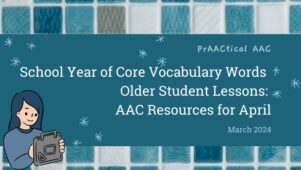
As March draws to a close, we extend our welcome to guest authors Michaela Sullivan and Lindsay Dougherty, who are back with another set of core vocabulary resources for teaching older students. Today, this dynamic team has a rich array of materials and suggestions to help them build fluency with the April core vocabulary words. They also discuss how to support AAC users during a popular classroom activity, shared reading. SCHOOL YEAR OF CORE- Older Student Lessons The Google Slide Resources Weeks 1-2 Google Slides Weeks 3-4 Google Slides INTRODUCTION- April 2024 Welcome back to the School Year of Core – Older student lessons for middle school to adult learners. How are things going? How are the resources working for you and your learners? We would love your feedback and your ideas. If you have any slides that you find work especially well for your students and adult learners, please... [Read More...]









